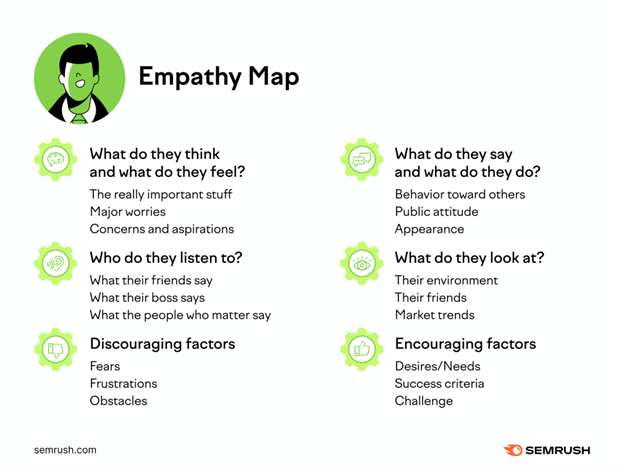Looking for this year’s keys to help you build your next content marketing strategy?
Wish you had a powerful content roadmap to help your business reach new heights in 2023?
Wondering what other content marketers have that you may be missing?
According to Semrush’s State of Content Marketing 2022 Report, 78% of marketers who believed their content marketing generated positive results had a documented content strategy.
So, how do you configure the right strategy to truly beat your competition?
The key to a successful content marketing strategy is to follow this ultimate content marketing checklist:
- Build buyer personas; explore your audience and find their pain points. This will help you become the most helpful resource on the web.
- Establish your brand story and make it shine through your future content.
- Set measurable content goals for the year.
- Run a content audit to find gaps in your existing inventory.
- Discover the topics your audience cares about the most.
- Optimize your content not only for the readers but also for search engines to gain more visibility.
- Pick the best content distribution channels.
- Use tools and templates to automate each step of the process.
This article will show you the steps to create an effective content marketing strategy and action plan, plus tell you the tools you’ll need along the way.
Develop Audience Personas With Buyer Persona Templates
Tool You’ll Need:
Who, exactly, are you targeting with your content?
What are goals they are struggling with that your content can help them achieve?
Without a solid understanding of who you’re targeting, it can be very difficult to discover what topics to cover and what content to create.
Without a clear audience in mind, you can’t create solution-oriented content, and you won’t have a clear, easy-to-formulate content plan.
Luckily, by uncovering who your target audience is with persona templates, you’ll be led straight to the ideal content for your audience.
These templates walk you through the process of defining your personas:
- Pain points.
- Motivations.
- Demographics.
- Preferred channels.
- Top influencers, and much more.
Once you know their pain points and can connect to your audience with true empathy, it’s easy to create helpful content that answers popular questions and offers solutions.
 Image created by Semrush, October 2022
Image created by Semrush, October 2022Establish Your Brand Story With Template Kits
Tool You’ll Need:
If you want your content to provide a correct and consistent image for your brand, you need to establish your brand story first.
You can glean valuable insight by examining your brand’s:
- Customers.
- Competitors.
- Unique value proposition in your market.
To establish your brand story, use this six-step storytelling template.
Use this as the element of your content strategy that allows you to build deeper connections with readers and customers.
Define Your Content Value Proposition & Mission Statement
Why should readers choose your content over your competitor’s?
What unique value does your content have that will encourage readers to finish articles, subscribe to your email list, and follow your brand?
Use the answers to these questions to define your content value proposition and formulate your content marketing mission statement.
The process of building your mission statement should include identifying your target audience and their goals, plus how your content will help the audience achieve those goals.
While I don’t have any tools for this purpose, I suggest using the following mission statements as examples to base yours on:
- “Educating and empowering the SEO community by providing the freshest news and latest best practices via the industry’s smartest practitioners.” (Search Engine Journal)
- “Our content is where digital marketing managers find multimedia information about SEO and content marketing so that they can help their companies grow via organic channels.” (Semrush)
Set Your Content Marketing Goals
Guide You’ll Need:
What goals do you expect your content to achieve to make a positive impact on your company’s bottom line?
Setting specific goals will allow you to determine if your content marketing strategy is serving its purpose.
According to 40+ marketers surveyed, the top content marketing goals are an increase in brand awareness, website traffic, and lead generation.
 Image created by Semrush, October 2022
Image created by Semrush, October 2022As you set goals for your content marketing strategy, use your company’s website analytics and social media insights tools. Determine if your content has had an impact on your metrics, and if so, by how much.
This will give you a baseline to work with as you prepare goals moving forward for your content strategy to measurably achieve specific key performance indicators (KPIs) and objectives and key results (OKRs).
Project management tools like Asana have goal-setting features within their product.
Sharing goals across the company allows everyone to know how their work applies to helping the company achieve business results.
Inventory Your Current Content Library
Tools You’ll Need:
You can’t complete a library without taking stock of what you have in your current inventory. A content audit allows you to see what content you have, exposing areas for optimization and improvement.
65% of the marketers who considered their content marketing efforts extremely successful ran content audits at least twice a year.
Of course, if you have a large website, auditing your content can be a tedious task. Fortunately, you can use a content audit tool to automate the process.
Using real-time metrics from Semrush, Google Analytics, and Google Search Console, the content audit tool will inspect your website’s folders and subfolders to reveal content that needs to be improved upon, rewritten, or removed to improve your overall content quality.
It will reveal the content topics that work best, the formats that lead to the most conversions, and the channels that drive the most traffic.
If you have published content on other websites, the post tracking tool can keep track of engagement metrics so that you know how your external content affects your overall content strategy.
Discover Topics To Cover In Seconds
Tools You’ll Need:
- 5-Second Topic Research Tool
- Keyword Research Tool
- Keyword Gap Tool
- Competitive Content Analysis Template
- Organic Research Tool
Your team and clients will be happy to know that topic research can be done in seconds, not hours. In fact, there are several ways to discover new content topics to cover on your website.
All you need is a single word or small sentence, and in just a few seconds the topic research tool generates:
- Tons of content ideas.
- Questions that people are asking right now.
- Hot trends, and more.
These can act as a basis for a high-performing, incredibly successful, and predictable content plan.
Once you have some high-level topics to work with, use the keyword magic tool to take a deeper dive into each. This tool will provide even more topics to cover plus popular questions to answer based on Google search popularity.
Another approach is to use the keyword gap tool to see what topics your competitors are covering successfully that you aren’t. It should reveal topics that your audience is interested in that you can approach from a unique perspective on your own website.
The competitive content analysis template will help you organize this information, along with other specific notes about your competitor’s approach to content. Document their tone of voice, main content formats, and topic categories.
You can also view your competitor’s top-performing content with the organic research tool. It may help you spot some topics that your brand could cover for more keyword visibility.
Optimize Your Content Before Publishing
Tool You’ll Need:
To ensure that your content aligns with your content strategy, use the SEO writing assistant. This content checker will suggest ways to improve your content to perform better with search engines and your target audience.
This tool uses the Flesch reading-ease score formula to help you to improve your content’s readability.
This may not be important to search engines, but it’s important in ensuring that readers can consume your content and take the desired next steps as directed by your calls to action.
With your content optimized, it’s time to plan how your team will deliver content to your ideal audience for maximum results.
Pick The Best Content Distribution Channels To Get The Most Clicks & Pageviews
Guide You’ll Need:
Once you build it and distribute it, they will come – especially if you’ve built a smart content distribution strategy.
Start with audience research in order to discover and understand who your ideal target audience is.
Ask yourself: “Who is going to benefit from my content the most?” “Will these people be interested in my product?” “Where can they be found?” and “Whose opinion do they trust?”
Now that your high-value content is selected, the next step in the Ultimate Guide To Content Distribution is distributing your content.
To ensure your content is getting maximum exposure, you’ll need to identify your owned media channels, earned and shared media channels, and paid media channels. Each channel opens a new door to viewership, allowing you to increase the number of leads entering your sales and marketing funnel.
 Image created by Semrush, October 2022
Image created by Semrush, October 2022Finally, be sure to select and track the right KPIs for each media channel:
This way, you can easily modify your content and calls to action to optimize your distribution strategy.
Get All The Tools In One Place: Semrush
I hope that these tools help you develop an effective, well-documented content marketing strategy that generates positive results for your business.
Be sure to continue monitoring your content performance and making sure that your content achieves the goals you have set out.
The opinions expressed in this article are the sponsor's own.



